Demythifying cognitive stereotypes on gender: do women really outshine men at multitasking?
In popular language, the word ‘multitasking’ refers to doing different tasks simultaneously, preferably as quickly as possible (Rosen, 2008). However, when approaching the term in scientific literature, the definition of multitasking may differ. As Stoet, O’Connor, Connor and Laws (2013) mention, the term multitasking can also be used to describe the ability to handle various task demands without the need to carry them out simultaneously. Hence, the term may be employed to describe the switching between multiple tasks, i.e. redirecting attention from one task to another (Buser & Peter, 2012).
In the current ‘multitasking society’ that strives towards maximum efficiency, productivity and speed, multitasking is not only perceived as a desirable skill, but it has become essential to excel in one’s student life or professional career (Salvucci & Taatgen, 2010). Given the growing necessity to multitask in our everyday life, not only should the underlying processes of multitasking be further explored, but also the individual differences in multitasking.
Gender and Multitasking
Discrepancy in the literature is dependent on the experimental definition of multitasking and nature of the paradigms employed in these studies. To illustrate, the study by Jing, Jing, Huajian, Chuangang and Yan (2012) indicates that women indeed have superior multitasking abilities than men. This finding is based solely on one type of multitasking paradigm: participants had to perform a task while being subjected to background music, thereby examining their selective attention. Hence, the conclusions of Jing et al. (2012) hold for the paradigm of selective attention. Meanwhile, Stoet et al. (2013) used both selective and divided attention as multitasking paradigms. The authors reported that although men and women perform equally well when engaged in the selective attention tasks, women are less distracted while performing divided attention tasks compared to men. In other research, some experimental paradigms on multitasking even showed that men outperform women (Mäntylä, 2013). Contradictory to the aforementioned studies, many other experiments found no differences, regardless of the type of attention employed, arguing that gender is a poor predictor of multitasking (Buser & Peter, 2012; Sanbonmatsu, Strayer, Medeiros-Ward and Watson, 2013).
The majority of the studies use response time as an indication of individual multitasking abilities. More recently, accuracy and the error rates have also been examined (Salvucci & Taatgen, 2010). Therefore, it is important to consider how multitasking performance is measured, i.e. which parameters are used to quantify the ability to multitask. For instance, one gender might multitask faster but with less accuracy compared to the other gender. Using different multitasking parameters across the research studies makes it hard to make general statements about the gender difference in multitasking and might lead to flawed conclusions.
It is also important to recognize which aspect of attention is required in such tasks. Particular type of attention might be more advanced in one gender, but this is insufficient to apply these findings to the broad cognitive phenomenon of attention. Regarding aspects of attention, Stoet (2017) reported that women were more easily distracted by task-irrelevant spatial information in multitasking paradigms (spatial attention). In line with the Hunter-gatherer evolutionary hypothesis, Stoet’s (2017) findings indicate that men can process and act upon spatial stimuli faster. In contrast, in studies where participants needed to attend to and recognize one particular feature of an object while ignoring another feature, women were less affected by task-irrelevant information compared to men (feature-centred attention) (Stoet, 2017). In these studies, both men and women responded faster and make fewer errors when the stimulus is congruent. In a congruent stimulus task, both the attended feature and inhibited features required the same response. Hence, attending to the wrong feature would not be classified as an error (Räsänen, 2018).
Based on the cited literature, we expect that the overall performance in the divided attention task will be worse in comparison with the task that requires selective attention. Thus, we hypothesise that the participants will take less time to complete the task and make fewer errors when they are not required to focus on two dimensions simultaneously. Considering the gender differences in multitasking, we expect the following based on the previous research:
1. Men and women will not have a different response time in the selective attention task;
2. Women will have a shorter response time than men in the divided attention tasks;
3. Women will make fewer errors than men in both tasks, and this effect will be even more evident when presented with incongruent stimuli.
For our study, we use a very similar experimental paradigm as the one employed in the first experiment of the study by Stoet et al. (2013). Hence, our study is a partial replication of their study. However, our participants are university students in the Netherlands. Hence, our participants are recruited from a different population (in terms of education, age and the geographical location) than those in the study from Stoet et al. (2013), in which participants were recruited via online advertisements and flyers in the UK. Whereas our study focuses on response time, error rates and the congruency effect across gender, the original study (Stoet at al. 2013) looked at different variables relevant for multitasking.
To study selective and divided attention in multitasking, we used a computer-based task-switching paradigm, where we compared performance on one pure task (responding consistently to either the shape or filling of the object presented on the screen, requiring selective attention) with performance when two tasks are mixed (responding alternatively to shape or filling task, requiring divided attention). The cue for whether the participant should complete the filling or shape task depends on the location of stimulus within the box (upper for shape or lower for filling) and the stimulus (the attentive object) are presented at the same time. Participants respond to the stimulus by pressing the corresponding keyboard button. Methodological details of our experimental paradigm are elaborated on below.
Methods
By means of convenience sampling, participants were recruited by 30 Erasmus University College students participating in the Cognitive Neuroscience course. Each student was asked to approach two individuals, resulting in a cumulative data set of 61 participants. Among the participants, 22 were male (36.1%) and 39 (63.9%) female. The age ranged from 14 to 56 years (M= 25.36, SD = 11.869). None of the participants received any incentive for their participation.
Materials
The participants took part in a multitasking PsyToolkit experiment designed by Stoet et al. (2013), which was accessible via their personal computers. Participants were presented with two different task
dimensions, namely a shape and filling task dimension. The tasks were displayed in a yellow rectangular frame comprised of two sections depicted on a black background. The upper section was labelled with the word “shape” and required the participant to complete the shape task, while the lower section was labelled with the word “filling” and required the filling task (Figure 1).

Figure 1. Representation of the displayed stimuli format which are displayed. Note that the presented stimulus is incongruent, since it requires opposite responses in the shape (“b”) and filling task (“n”).
In the shape task, participants had to respond to whether the shape of the frame was a diamond or rectangle by pressing the letter “b” or “n” on their keyboard, respectively. In the filling task, participants had to assess the number of yellow dots presented within the shape. Two dots required participants to press the letter “b” while three dots required pressing the letter “n”.
Besides focusing on these individual tasks one at a time, in one section of the experiment participants were also asked to focus on the two tasks simultaneously. There, the shape and filling tasks were randomly alternated. Participants had to process the location in which the stimulus appeared (upper/lower part of the box) before knowing whether they need to respond to the shape or filling. Our experimental paradigm is a form of Go/No-go task, because participants had to react on the cue (e.g.: shape of the stimulus) by pressing a corresponding button on a keyboard, while inhibiting the response associated with another feature (e.g.: filling of the stimulus).
Experimental procedure
To familiarize the participants with the experiment, a training block of 40 trials was presented (10 for performing shape tasks, 10 for filling tasks and 20 for both tasks combined). These results were not further used for data analysis.
The experiment used for data analysis consisted of three different blocks with a total of 192 trails. In block 1, participants were asked to perform 48 trials of the shape task. Block 2 consisted of 48 trials of the filling task. In block 3, the filling task and shape task were combined across 96 trials by displaying 96 stimuli on either the upper or lower section. For this study, block 1 and 2 are defined as selective attention tasks since participants were asked to focus on a single task (shape/filling). Block 3 required divided attention as participants had to focus on the tasks simultaneously. Participants had up to 4 seconds to respond before a new stimulus appeared. In the case of an absence of response or an incorrect response, a reminder of the task descriptions was displayed for 3 seconds before the next trial. Figure 2 illustrates various displays that participants could encounter while performing the tasks.

Figure 2. Overview of the possible frames in PsyToolkit experimental, using the shape task (a selective attention task) an example. The type of task was first announced as preparation. If participants responded correctly to the imperative stimulus (Go trail), a new stimulus was shown after a short pause of 800 milliseconds (ms). Once the participant failed to respond within 4000 ms, “Time is up” frame was shown for 1000 ms as a negative feedback, followed by a reminder of the instructions for 3000 ms. After a pause of 500 ms, a new imperative stimulus was initiated. When failing to respond correctly, a frame stating “That was the wrong key!” was displayed for 1000 ms, followed by a reminder of the instructions and a new stimulus.
Data analysis
Response times of all participants were assembled in an SPSS data file on IBM SPSS Statistics 24, which incorporated data from all 192 trials. The overall error rate and incongruent error rate made when the stimuli required opposite responses in the shape and filling task (Figure 1), were calculated for each participant.
Design. In our analysis we have used mean as a measure of central tendency and standard deviation as a measure of dispersal. In order to determine whether there is a significant difference in response time and error rate in selective attention and divided attention tasks between men and women, this study used the mixed-design ANOVA analysis. Our two within-subject factors were selective and divided attention tasks, while gender (male/female) represents the between-subjects factor (Figure 3). By performing a mixed-design ANOVA, the main effects of gender (male or female) and type of task (selective or divided), as well as the effect of the performed task conditional on gender, could be examined.

Figure 3. Outline of the between-subject and within-subject factors to perform a mixed-design ANOVA analysis.
Response Time
Firstly, we examined the response times of all 192 trials (Table 1). The mean response time of all participants in the selective attention task was 548.32 ms (SD= 105.19). Overall, the mean response time for the divided attention task was higher, with the mean of 961.7 ms (SD=
225.51). The same direction of the slow down effect was observed for both genders. Both men and women had a shorter response time in the selective attention (pure) task, compared to the divided attention (mixed) task. Our descriptive statistics show that men have a faster mean response for both types of tasks compared to women. However, the difference is small and there is a greater variation in individual performances among men.
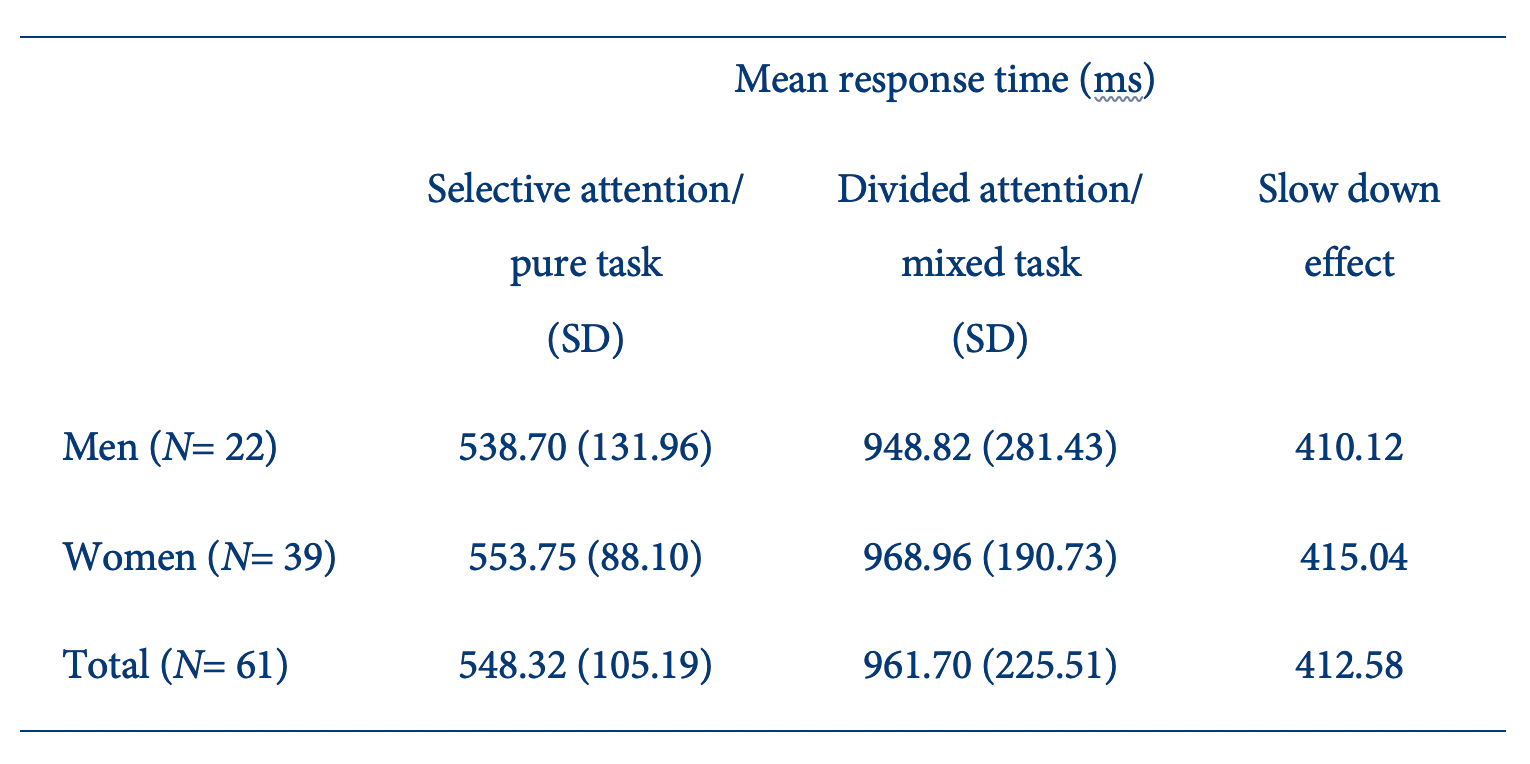
Table 1 Descriptive statistics for the mean response times in the selective attention and divided attention tasksTo test whether the aforementioned effects are significant, we performed a mixed-design ANOVA (Table 2).
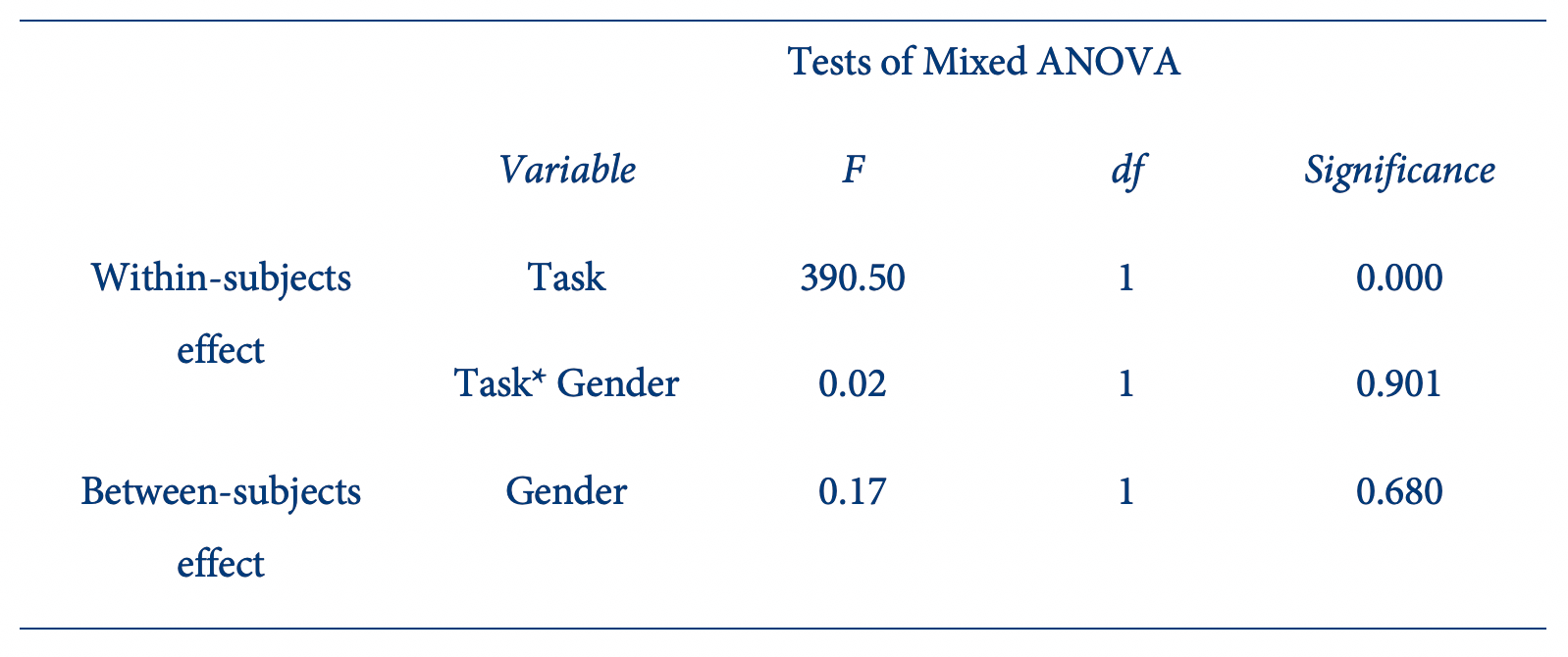
Table 2 Mixed-design ANOVA analysis for the mean response time in the selective vs divided attention tasks in men and womenThe main effect of gender alone was not significant, F(1, 59) = 0.17, p = .68, suggesting that the response times of male and female participants were not significantly different, regardless of the task performed. A significant main effect of the performed task type was found, F(1, 59) = 390.50, p < .001, which implies that independent of gender, the response time differed significantly between tasks. All male and female participants had a faster mean reaction time to the selective attention task compared to the divided attention task.
There was no significant interaction effect found between the gender and the type of task, F(1, 59) = 0.02, p = .90. Therefore, men and women followed the same performance trend in the different tasks and did not show a differential response time for selective attention and divided attention tasks.
Accuracy and Error Percentage
Next, we analysed the errors participants made during the experiment as a percentage of all trials. Furthermore, we looked at the error rate in the trial when participants responded to incongruent stimuli. Descriptive statistics are displayed below (Table 3).
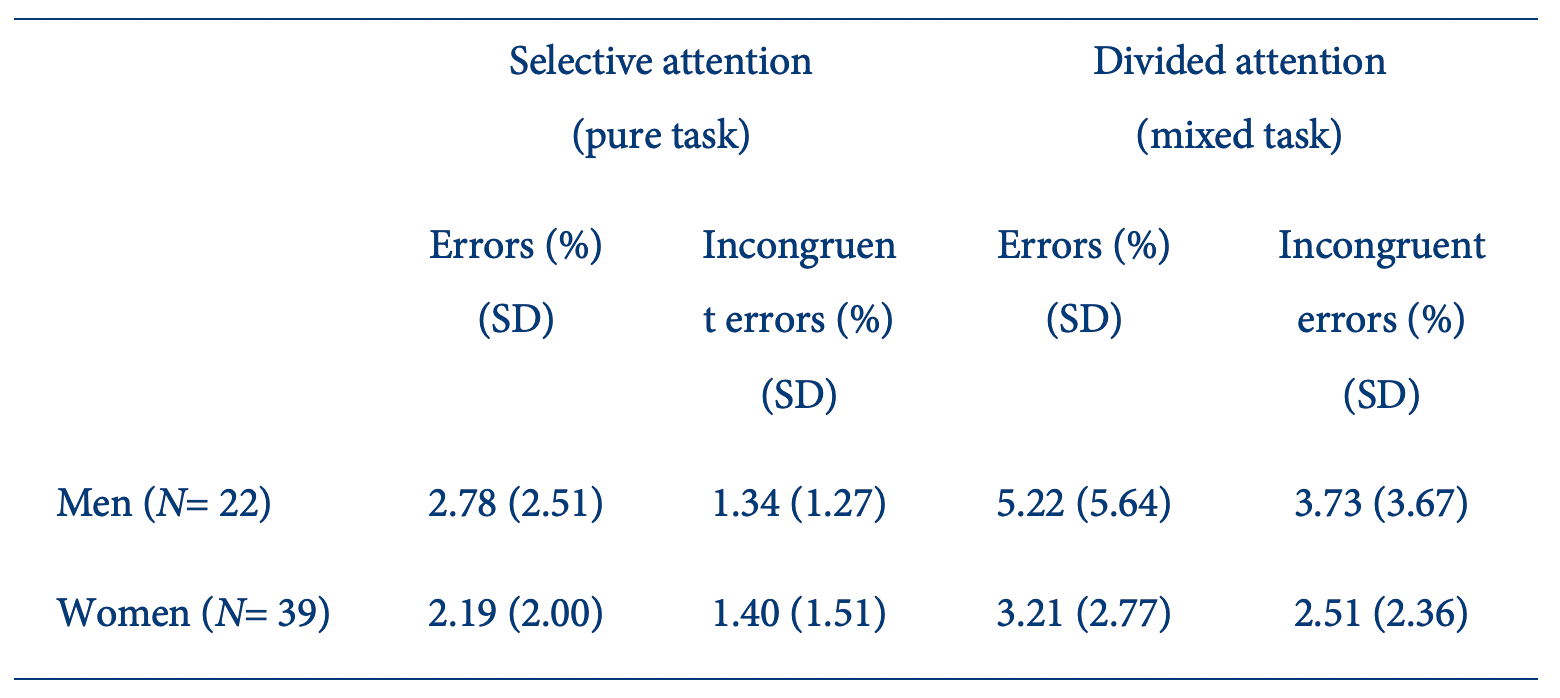
Table 3 Descriptive statistics for the mean percentage of all errors and incongruent errors in selective vs divided attention tasks for men and womenRegarding the overall errors made in the selective attention (pure) task, both men and women had a similar error percentage of 2.78% and 2.19%, respectively. Similar results were observed for the incongruent errors made in the selective attention (pure) task among men and women, whose rates were 1.34% and 1.40%, respectively.
More errors were made by both genders in the divided attention (mixed) task. However, the error rate for women in this task was smaller (3.21%) compared to men (5.22%). Incongruent errors made in the divided attention (mixed) task followed a similar distribution, in which women had an error rate of 2.51% and men 3.73%. To infer the significance of these effects, our results were analysed by mixed-design ANOVA (Table 4 and 5).
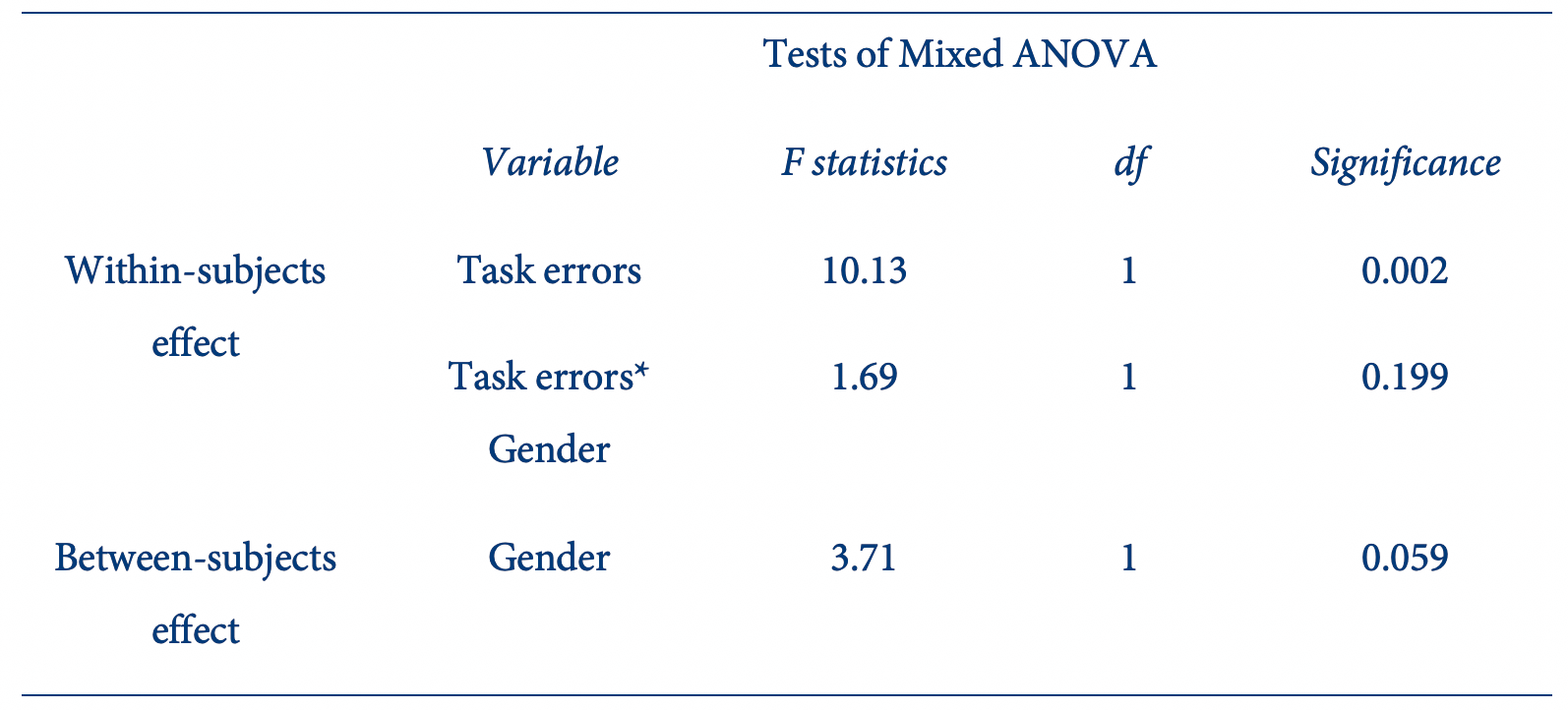
Table 4 Mixed-design ANOVA analysis of the errors rates in the selective vs divided attention tasks among men and womenFirstly, the overall error rate was examined. There was a significant main effect of task type on error rate, F(1, 59) = 10.13, p < .01, which implied that all participants made a significantly different number of errors based on the type of task. Participants made fewer errors in the pure task than the divided attention task (Table 3). Although there was a difference between male and female error rates, the effect of gender alone was not significant, F(1, 59) = 3.71, p = .06. The interaction effect between gender and task errors was not significant either, F(1, 59) = 1.69, p = .20. Thus, there was no interaction found between gender and error percentage in the specific type of task.
We then looked at whether the error effect would be the same for the incongruent stimuli (Table 5). Despite the sub-analysis of errors in the more demanding stimuli, results follow the same direction as in the overall error rate.
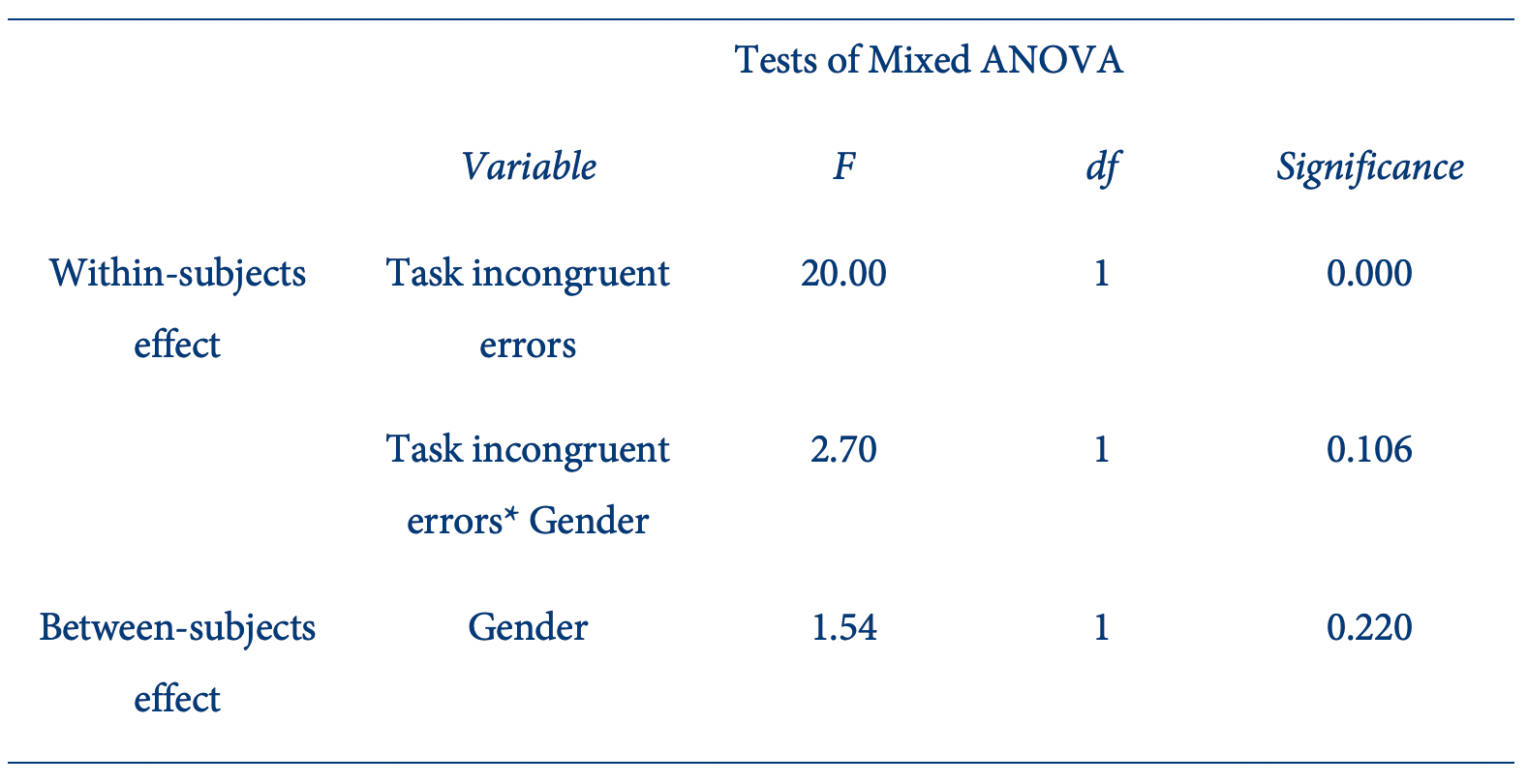
Table 5 Mixed ANOVA analysis of the incongruent errors rates in selective vs divided attention task for men and womenMain effects of the incongruent errors based on the type of attentive task (F(1, 59) = 20.00, p < .001) and gender alone (F(1, 59) = 2.70, p = .11) were insignificant. Although the direction of the task error differed between men and women, where women made more errors in the pure task while men made more errors in the mixed task (Figure 3), there was no significant interaction effect (F(1, 59) = 1.54, p = .22).

Figure 3. Estimated incongruent task errors*gender interaction effect in the selective (pure) and divided attention task (mixed).
Although we found that men had a slightly faster response for both selective and divided attention tasks than women, contradicting the Hunter-gatherer evolutionary hypothesis and widespread gender stereotype, our results did not show that gender significantly affects response time. Furthermore, we have not found that the pattern of responses in our multitasking paradigm differs between gender. In conclusion, no interaction effect was detected between gender and the response time for the tasks. Thus, we accept our first hypothesis that men and women do not have a different response time in the selective attention task. However, we reject the second hypothesis, which states that women have a shorter response time than men in the divided attention tasks.
As for the prevalence of error making, in our study both men and women made more errors in the divided attention task than in the selective attention tasks. We hypothesized that men make more errors than women in both selective and divided attention tasks, based on research performed by Stoet (2017). We expected to observe the same pattern for incongruent stimuli trials (Räsänen, 2018). However, our results indicated that for both the percentage of overall errors and the incongruent errors, men and women showed no significant difference in the correctness of their responses in either of the attentive tasks. Therefore, our third hypothesis that women make fewer errors than men with a stronger effect for the incongruent stimuli, is rejected.
Interestingly, error making differences in men and women were close to reaching the significance level (p = .06). Although not significant, our findings indicated that men made more errors than women in both task types, in agreement with our third hypothesis. Lack of the statistical significance could be attributed to the small sample size of this study. Hence, a larger sample size could have increased the statistical power of this study, which would have enabled us to detect the smaller effects.
Another limitation of our study was that the sample group was not gender-balanced, as we had 22 men and 39 women. The mean age of the sample group was fairly low, since the recruiters could easily reach out to fellow students of a similar age to participate in the study. The sample group thus contained an overrepresentation of adolescents with similar educational backgrounds, thereby not being representative of the whole population. As the study by Räsänen (2018) indicates, the brain areas involved in attentional tasks, the parietal and prefrontal brain areas, are not fully developed until adulthood. Moreover, Saxena et al. (2017) notes that adolescence is a critical period of development for learning how to successfully coordinate two different tasks. Gender differences while performing selective and divided attention tasks may not be perceivable during the adolescent stage, thereby skewing our results.
Lastly, we had no control on the setting and the time of day in which the participants performed the experiment. While some participants performed the experiment in a quiet setting, others may have been distracted by audio-visual stimuli in their surroundings. These variations of experimental setting could have interfered with our findings.
In conclusion, our study found no significant differences in response time in selective and divided tasks between men and women. Hence, in contemporary society where multitasking is valued as a highly desirable skill, gender stereotypes rooted in the Hunter-gatherer evolutionary hypothesis may portray an inaccurate depiction of actual gender differences. This is important to discuss as, due to the widely believed stereotype, women may be unrightfully expected to organise and perform more tasks within their households and jobs, compared to men.
Finally, although not significant, our results indicate gender differences in accuracy: men made more errors than women in both selective and divided attention task types. Hence, future studies could explore this effect. In order to strengthen our conclusions, future research should be conducted on a larger, gender-balanced sample group with a higher control of the experimental environment. Replicating our study in a wider age range and more educationally diverse sample would enable exploration of the gender effect in multitasking at the general population level.
I would like to thank Dr Chris Müller for providing feedback on this paper. Special thanks go to my dear colleague Borah Spoorenberg, whose support and help with the data processing and discussion of the results was of immense help.
REFERENCES
Buser, T., & Peter, N. (2012).
Multitasking. Experimental Economics, 15(4), 641-655.
https://doi.org/10.1007/s10683-012-9318-8
Field, A. P. (2005). Discovering statistics using SPSS
(second edition). London: Sage.
Mäntylä, T. (2013). Gender differences in multitasking reflect spatial ability. Psychological science, 24(4), 514-520. https://doi.org/10.1177/0956797612459660
Pashler, H. (1994). Dual-task
interference in simple tasks: data and theory. Psychological bulletin,
116(2), 220. https://doi.org/10.1037/0033-2909.116.2.220
Ren, D., Zhou, H., & Fu, X. (2009). A deeper look at
gender difference in multitasking: Gender-specific mechanism of cognitive
control. In 2009 Fifth International Conference on Natural Computation
(Vol. 5, pp. 13-17). IEEE. https://doi.org/10.1109/ICNC.2009.542
Rosen, C. (2008). The myth of multitasking. The New
Atlantis, (20), 105-110.
Salvucci, D. D., & Taatgen, N. A. (2010). The multitasking mind. Oxford University Press.
Sanbonmatsu, D. M., Strayer, D.
L., Medeiros-Ward, N., & Watson, J. M. (2013). Who multi-tasks and why? Multi-tasking ability, perceived multi-tasking ability,
impulsivity, and sensation seeking. PloS
one, 8(1), e54402. https://doi.org/ 10.1371/journal.pone.0054402
Saxena, S., Cinar, E., Majnemer, A., & Gagnon, I. (2017). Does dual tasking
ability change with age across childhood and adolescence? A systematic scoping review. International journal of developmental
neuroscience, 58, 35-49. https://doi.org /10.1016/j.ijdevneu.2017.01.012
Stoet, G. (2017). Sex differences
in the Simon task help to interpret sex differences in selective attention. Psychological
research, 81(3), 571-581. https://dx.doi.org/10.1007%2Fs00426-016-0763-4
Stoet, G., O’Connor, D. B.,
Conner, M., & Laws, K. R. (2013). Are women better than men at multi-tasking?. BMC Psychology, 1(1), 18.
https://dx.doi.org/10.1186/2050-7283-1-18
Szameitat, A. J., Hamaida, Y., Tulley, R. S., Saylik, R., & Otermans, P. C.
(2015). “Women are better than men”–Public beliefs on gender differences and
other aspects in multitasking. PloS one,
10(10), e0140371. https://dx.doi.org/10.1371/journal.pone.0140371
